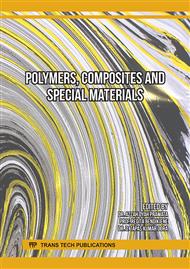[1]
M. G. Dersseh, A. M. Melesse, S. A. Tilahun, M. Abate, and D. C. Dagnew, "Water hyacinth: Review of its impacts on hydrology and ecosystem services-Lessons for management of Lake Tana," in Extreme Hydrology and Climate Variability: Monitoring, Modelling, Adaptation and Mitigation, Elsevier, 2019, p.237–251.
DOI: 10.1016/B978-0-12-815998-9.00019-1
Google Scholar
[2]
B. Agri, M. Fawad, and A. Jamal, "Black Sea Journal of Agriculture WATER HYACINTH: UTILIZATION AND IMPACT ON BIODIVERSITY," 2019. [Online]. Available: https://orcid.org/0000-0002-3518-2399
Google Scholar
[3]
S. Bolenz, H. Omran, and K. Gierschner, "Treatments of Water Hyacinth Tissue to Obtain Useful Products," 1990.
DOI: 10.1016/0269-7483(90)90130-k
Google Scholar
[4]
N. Merry and M. Mitan, "Water hyacinth: Potential and Threat," 2019. [Online]. Available: www.sciencedirect.comwww.materialstoday.com/proceedings2214-7853
Google Scholar
[5]
M. N. Islam et al., "Water hyacinth (Eichhornia crassipes (Mart.) Solms.) as an alternative raw material for the production of bio-compost and handmade paper," J Environ Manage, vol. 294, Sep. 2021.
DOI: 10.1016/j.jenvman.2021.113036
Google Scholar
[6]
S. Rezania et al., "Evaluation of water hyacinth (Eichhornia crassipes) as a potential raw material source for briquette production," Energy, vol. 111, p.768–773, Sep. 2016.
DOI: 10.1016/j.energy.2016.06.026
Google Scholar
[7]
A. Krismariono, E. M. Setiawatie, R. Y. Rachmawati, Y. A. Setiawan, H. N. Padmarini, and N. A. Apriliyanti, "Antibacterial Activity of Water Hyacinth (Eichhornia Crassipes) Leaf Extract Against Bacterial Plaque from Gingivitis Patients," Journal of International Dental and Medical Research, vol. 15, no. 3, p.966–971, 2022.
DOI: 10.30574/wjarr.2022.16.1.1099
Google Scholar
[8]
S. Kiatkamjornwong, "Superabsorbent Polymers and Superabsorbent Polymer Composites," ScienceAsia, vol. 33(s1), p.039, 2007.
DOI: 10.2306/scienceasia1513-1874.2007.33(s1).039
Google Scholar
[9]
A. Pourjavadi, M. S. Amini-Fazl, and M. Ayyari, "Optimization of synthetic conditions CMC-g-poly (acrylic acid)/Celite composite superabsorbent by Taguchi method and determination of its absorbency under load," Express Polym Lett, vol. 1, no. 8, p.488–494, 2007.
DOI: 10.3144/expresspolymlett.2007.69
Google Scholar
[10]
S. K. H. Gulrez, S. Al-Assaf, and G. O, "Hydrogels: Methods of Preparation, Characterisation and Applications," in Progress in Molecular and Environmental Bioengineering - From Analysis and Modeling to Technology Applications, InTech, 2011.
DOI: 10.5772/24553
Google Scholar
[11]
T. Puspasari, "PREPARATION OF CASSAVA STARCH-BASED SUPERABSORBENT POLYMER NANOCOMPOSITE (SAPNC) Cellulose membrane for dehumidification application View project Master Projects View project," 2016. [Online]. Available: https://www.researchgate.net/publication/310686407
Google Scholar
[12]
J. Shantha Siri, C. Fernando, and S. de Silva, "A Novel Method to Produce Cost Effective, Environment Friendly Superabsorbent from Water Hyacinth for Sustainability-Driven Medical Applications," Int J Clin Med Info, vol. 3, no. 2, p.46–56, 2020, [Online]. Available: www.tridhascholars.org
Google Scholar
[13]
B.-J. Kim, Y.-S. Lee, and S.-J. Park, "Preparation of platinum-decorated porous graphite nanofibers, and their hydrogen storage behaviors," J Colloid Interface Sci, vol. 318, no. 2, p.530–533, Feb. 2008.
DOI: 10.1016/j.jcis.2007.10.018
Google Scholar



